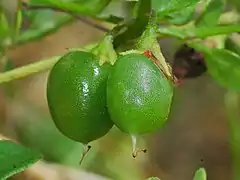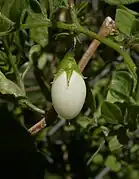Salpichroa origanifolia
Salpichroa origanifolia is a species of flowering plant in the nightshade family known by the common names lily of the valley vine, [2] pampas lily-of-the-valley[3] or cock's-eggs.[4]
| Salpichroa origanifolia | |
|---|---|
 | |
| Flower of Salpichroa origanifolia | |
| Scientific classification | |
| Kingdom: | Plantae |
| Clade: | Tracheophytes |
| Clade: | Angiosperms |
| Clade: | Eudicots |
| Clade: | Asterids |
| Order: | Solanales |
| Family: | Solanaceae |
| Genus: | Salpichroa |
| Species: | S. origanifolia |
| Binomial name | |
| Salpichroa origanifolia | |
| Synonyms | |
| |
Distribution and habitat
This species is native to South America (Brasil, Bolivia, Peru, Argentina, Chile, Paraguay, Uruguay) and is naturalised in Africa (Algeria, Morocco, Tunisia), Australasia, Europe (United Kingdom, Italy, Spain, France, Portugal), and North America (United States, Mexico).[5] This plant is present in grasslands, roadsides and in neglected areas and may occasionally occur in gardens, at an elevation up to 100 metres (330 ft) above sea level. [3]
Description

Salpichroa origanifolia can reach a stem length of about 2–3 m (6 ft 7 in – 9 ft 10 in). This perennial, rhizomatous, decumbent to climbing, hairy vine has a trailing, highly branched, four-cornered zig-zagging stems. Leaves are glabrous, widely elliptic to ovate or also rounded and can reach a length of about 10–35 mm (0.39–1.38 in), with a petiole of about 5–10 mm (0.20–0.39 in). The flowers are rather small, 1–1.5 cm (0.39–0.59 in) long and are born from the axils of the leaves. The calyx lobes reach 2–3 mm (0.079–0.118 in). Corolla is bell-shaped or urn-shaped, white or greenish. Anthers reach 1.5–2 mm (0.059–0.079 in). Fruits can reach 10–15 mm (0.39–0.59 in). They are ovoid berries, ill-smelling and turn white or pale yellow when ripe. [3][6]
Biology
This invasive vine commonly spreads via seeds and fragments of roots. Seeds germinate from early Spring to late Summer. Flowering occurs at any time but especially in Summer and bears fruits in Autumn.[3]
Human culture
Lily of the valley vine is commonly grown as an ornamental plant in some countries. In others, it is considered an invasive weed . In Tasmania, it is regarded as a toxic weed and its sale and distribution are illegal. [3]
Gallery
 Plant in flower
Plant in flower Ripe fruit
Ripe fruit Leaves
Leaves
References
- GBIF
- "Salpichroa origanifolia". USDA Plants Profil
- "Pampas Lily-of-the-Valley". Department of Primary Industries, Parks, Water and Environment, Tasmania. 2020-12-04. Retrieved 2020-12-04.
- BSBI List 2007 (xls). Botanical Society of Britain and Ireland. Archived from the original (xls) on 2015-06-26. Retrieved 2014-10-17.
- Germplasm Resources Information Network (GRIN). Agricultural Research Service (ARS), United States Department of Agriculture (USDA).
- Jepson Flora Project: Jepson Interchange